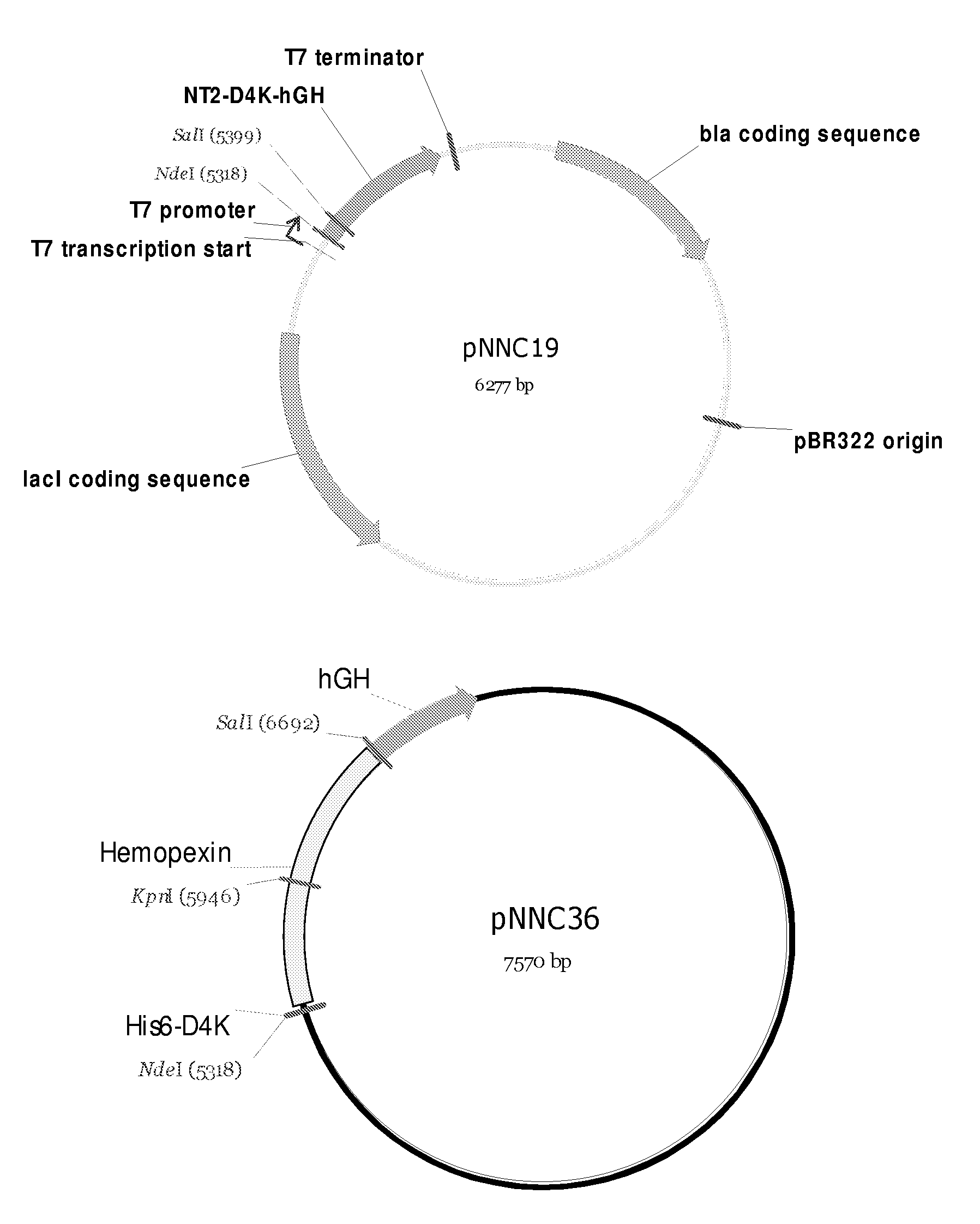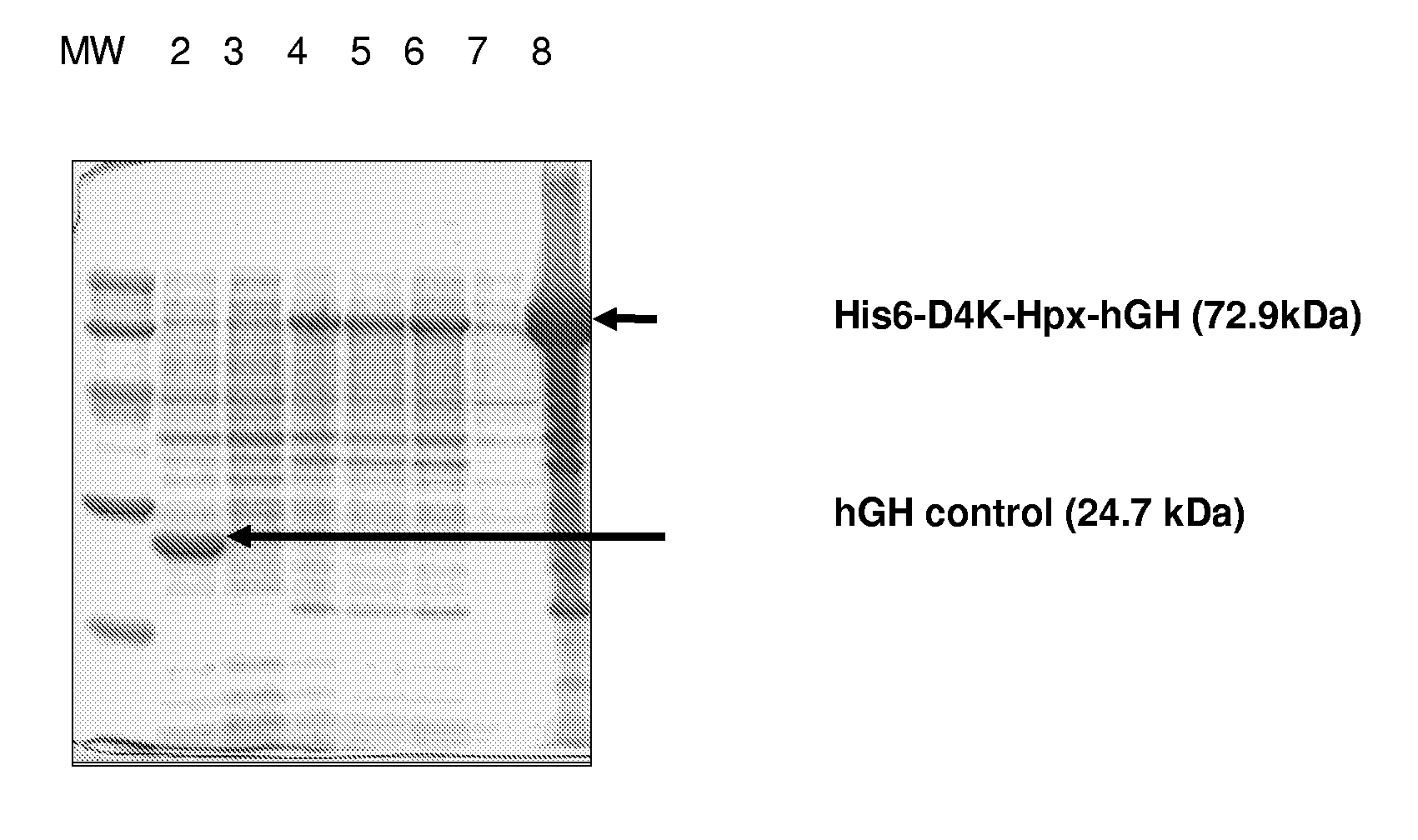Hemopexin fusion proteins
a technology of fusion proteins and hemopexins, applied in the field of fusion proteins of hemopexins, can solve the problems of short half-lifes in circulation of very short therapeutic potentials of novel proteins as well as “old” and well-established proteins
- Summary
- Abstract
- Description
- Claims
- Application Information
AI Technical Summary
Benefits of technology
Problems solved by technology
Method used
Image
Examples
example 1
Hemopexin Cloning
[0174]Four hemopexin protein sequences were found in the NCBI protein database (gi: 1708182; 2144904; 226337; 386789). These where aligned and found to be identical using Vector NTI software. A corresponding cDNA sequence representing linear mRNA (gi: 11321560) was used as template for primer design. The primers were designed to exclude the signal peptide (see below). A nested primer PCR strategy was utilized with a short Hpx-specific primer set to amplify Hpx from oligo (dT) primed double stranded human liver cDNA (BD Bioscience), and a longer primer set containing an additional purification tag (His6), an enterokinase cleavage site (D4K), a short hGH linker sequence, as well as Nde1 and Sal1 restriction sites for cloning into a bacterial expression vector (pNNC19) already containing the hGH gene (see FIG. 1). High fidelity DNA polymerase was used for 25 PCR cycles with the short primer set and the identity of the amplicon confirmed by gel electrophoresis (amplicon...
example 2
Hpx-hGH Cloning
[0177]The ends of the amplicon obtained in Example 1 were cut with Nde1 and Sal1 and the fragment cloned in pNNC19. Positive clones were selected using restriction enzyme analysis and the sequence of the fusion protein confirmed by DNA sequencing. The resulting expression vector encodes a fusion protein containing Met-His6-D4K-Hpx-hGH (see FIG. 1).
example 3
Expression and Isolation of His6-D4K-Hpx-hGH
Expression
[0178]Expression was performed at standard conditions using different temperatures and concentrations of IPTG. Briefly, E. coli bacteria were grown to an OD600 nm of 0.6 and expression was induced with IPTG for approximately 4 hours. The bacteria pellet was harvested and the protein content investigated for the presence of recombinant fusion protein using SDS PAGE (see FIG. 2). The Hpx fusion protein was found mainly in inclusion bodies in all conditions tested.
Refolding and Purification
[0179]After solubilisation of His6-D4K-Hpx-hGH inclusion bodies (in 8 M Urea, 20 mM DTT, 20 mM Tris pH 9.0), the protein was refolded by 50-fold dilution refolding in 1 M NDSB201, 1 M Urea, and 20 mM Tris pH 9.0 over night. Correct refolding of the hemopexin part of the fusion protein was shown by its ability to bind hemin. Hemin binding is dependent on the coordinated binding of histidine 213 and 270 to the heme iron forming a stable bis-histidyl...
PUM
| Property | Measurement | Unit |
|---|---|---|
| Fraction | aaaaa | aaaaa |
| Fraction | aaaaa | aaaaa |
| Atomic weight | aaaaa | aaaaa |
Abstract
Description
Claims
Application Information
 Login to View More
Login to View More - R&D
- Intellectual Property
- Life Sciences
- Materials
- Tech Scout
- Unparalleled Data Quality
- Higher Quality Content
- 60% Fewer Hallucinations
Browse by: Latest US Patents, China's latest patents, Technical Efficacy Thesaurus, Application Domain, Technology Topic, Popular Technical Reports.
© 2025 PatSnap. All rights reserved.Legal|Privacy policy|Modern Slavery Act Transparency Statement|Sitemap|About US| Contact US: help@patsnap.com



